Cart Checkout Solutions: Comparing Traditional vs. Vision-Powered Systems for Retail Efficiency
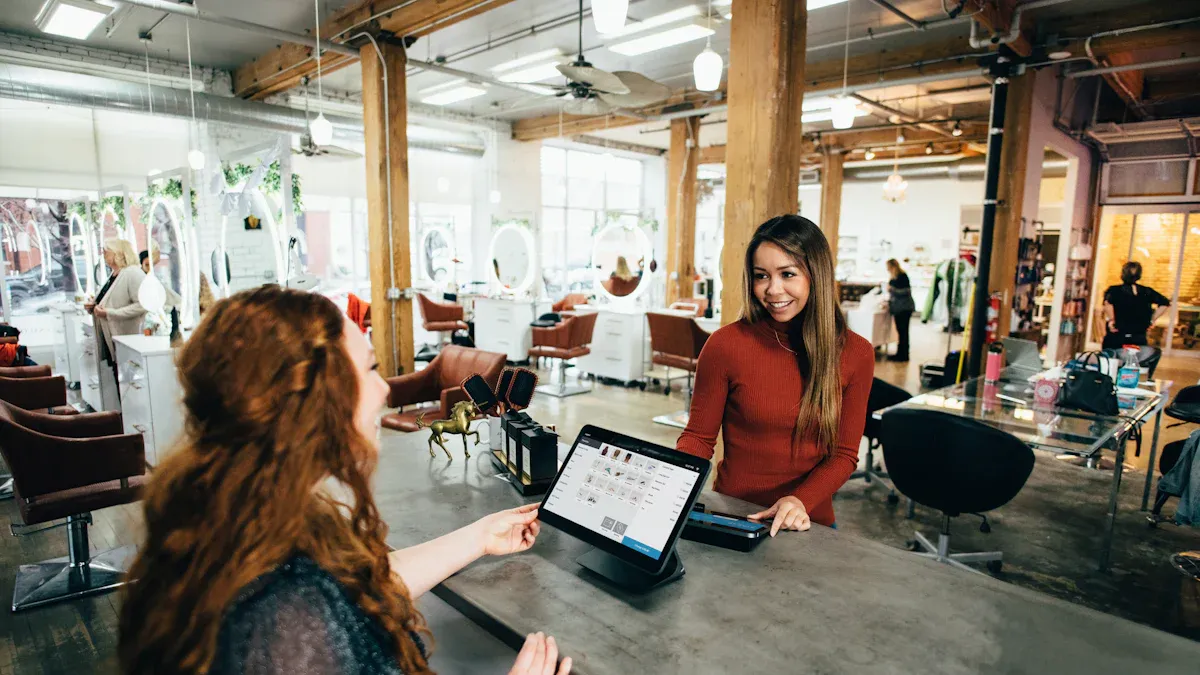
Efficient cart checkout solutions are crucial in today’s stores. Retailers, especially in the fashion industry, often experience significant sales losses, with fashion stores seeing 81.3% of carts left behind. This highlights the pressing need for improvement. Checkout systems that are easy and flexible can make a substantial difference. For instance, ASOS successfully reduced cart abandonment by 17% by enhancing their checkout process.
New vision-powered systems are revolutionizing store operations. These systems utilize smart cameras to analyze shoppers and automate tasks, leading to faster and more efficient store management compared to traditional methods. With features like instant item scanning and automatic payments, these systems are transforming the shopping experience.
Stores implementing vision-based technology have reported remarkable improvements. Sales increased by 8.4%, and customer return rates rose by 27%. These innovative tools demonstrate how shopping can become quicker, smarter, and more convenient for everyone.
Key Takeaways
Vision-powered systems use smart cameras to make checkout faster. They are 75% quicker than old-fashioned methods.
Stores with vision-powered tech have happier customers. Satisfaction goes up by 20% because shopping is faster and easier.
Old checkout systems often mean long lines and more workers. This raises costs for the store.
Using vision-powered systems can save money on workers and work better. This makes them a good choice for stores.
Both systems have good points, but vision-powered ones grow better. They can change easily to meet what customers want.
Traditional Cart Checkout Solutions
How Traditional Checkout Systems Work
Traditional checkout systems are important for running stores smoothly. They help customers finish shopping by scanning items, adding totals, and taking payments. Stores try to make these systems simple to stop people from leaving their carts, which happens about 70% of the time.
Key parts of good checkout systems include:
Easy-to-use screens to avoid confusion.
Steps showing how close customers are to finishing.
Different ways to pay to suit everyone.
Safety tools like SSL to keep payments secure.
Many stores now focus on mobile-friendly systems since people shop more on phones. These systems aim to be fast, easy, and trustworthy, showing stores care about their customers.
Common Features of Traditional Systems
Traditional checkout systems have tools to make shopping easier. Below is a table showing popular features:
Feature | Description |
|---|---|
Contactless Payment Methods | Most payments are contactless, making them quick and safe. |
Many shoppers, especially younger ones, like self-checkout kiosks for speed. | |
Mobile Checkout | Store workers use phones to help customers pay anywhere in the store. |
These features help customers check out faster and with less waiting. Self-checkout kiosks are popular because they let people pay on their own.
Limitations of Traditional Checkout Systems
Even though traditional systems are common, they have problems in busy stores. Customers often face delays that make shopping harder. Below is a table showing some issues:
Statistic | Percentage |
|---|---|
Customers needing help during self-checkout | |
Customers stopped by staff to check their purchases | 30% |
Customers liking self-checkout more with better technology | 60% |
Customers saying faster checkout improves their experience | 25% |
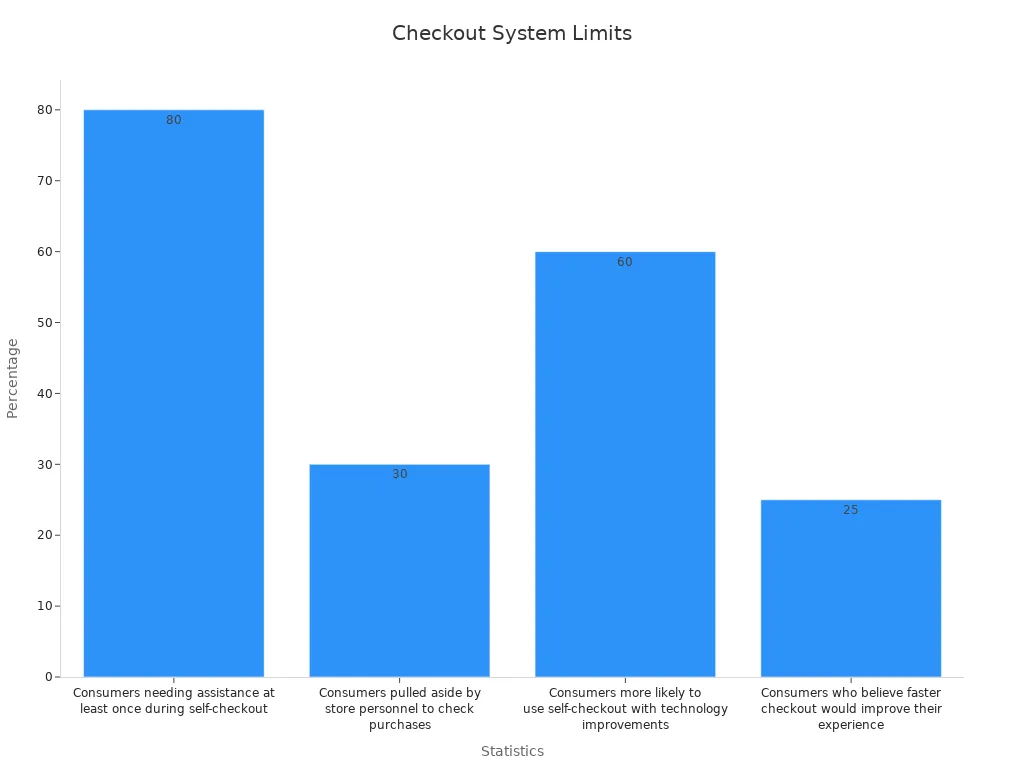
These problems show why stores need better systems. For example, 80% of people using self-checkout still need help, which slows things down. Also, forcing customers to make accounts can annoy them and cause them to leave. Faster and smarter checkout systems can fix these issues and meet what shoppers want today.
Vision-Powered Cart Checkout Solutions
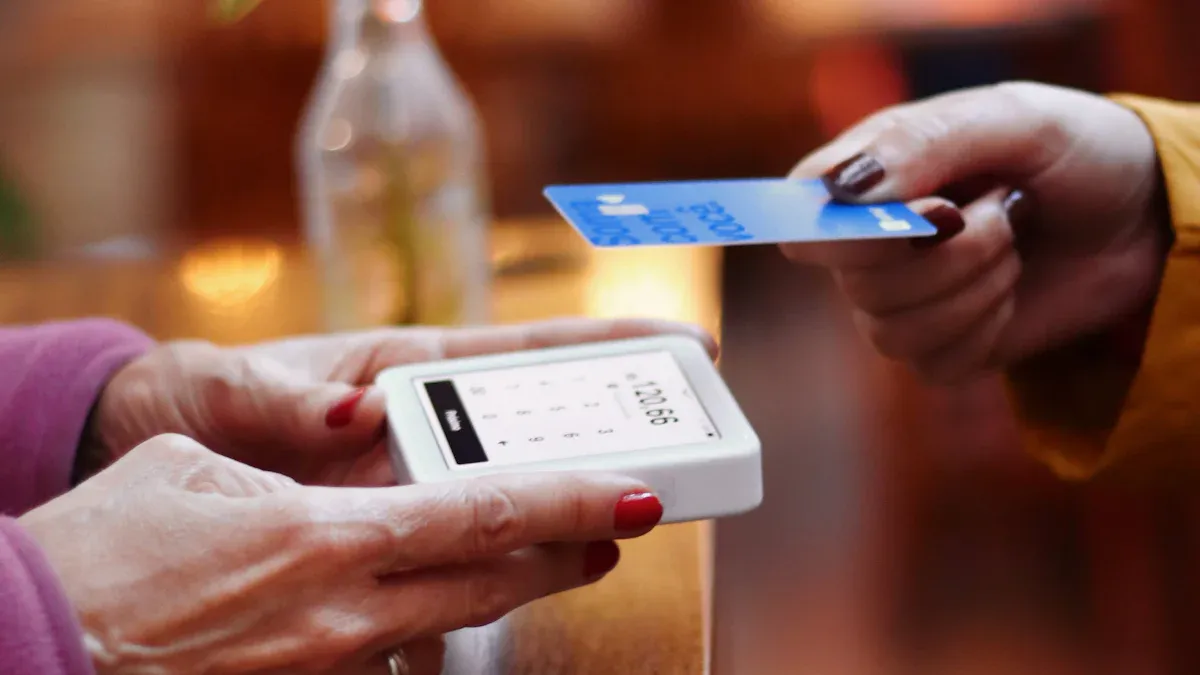
How Vision-Powered Systems Use Smart Cameras
Vision-powered checkout systems use smart cameras to improve shopping. These cameras, powered by AI, can recognize items instantly. Instead of scanning barcodes, they "see" products visually, making checkout faster. For example, Amazon's Just Walk Out lets shoppers skip scanning and leave quickly.
These systems make shopping easier for customers. They track items automatically, so cashiers or scanning apps aren't needed. This makes shopping smoother and quicker. Stores also benefit by learning how customers shop. This helps them arrange products better and manage stock efficiently.
Features of Vision-Powered Systems
Vision-powered systems have advanced tools that help stores and shoppers. Below is a table showing their benefits:
Feature | Description |
|---|---|
Items are scanned automatically, speeding up checkout. | |
Easy Payments | AI cameras handle payments without needing workers. |
Better Convenience | Shoppers spend less time waiting and enjoy smoother shopping. |
Shopper Insights | Stores collect data to improve layouts and marketing. |
Mobile Payment Integration | Combines cameras with payment apps for faster transactions. |
These features make vision-powered systems a big improvement for stores. They save time, boost efficiency, and make shopping more enjoyable.
Cloudpick's Unmanned Store: A Smart Shopping Example
Cloudpick's Unmanned Store shows how vision-powered systems work. This store has smart shelves and sensors to track items. Cameras use visual data to identify products and watch customer actions. This creates a smooth shopping experience.
The store is open all day, cutting labor costs and improving operations. It also gives stores useful data to automate tasks. Smart cameras track items accurately, while AI helps manage stock. Cloudpick shows how vision-powered systems combine ease, speed, and new technology to change retail.
Comparing Cart Checkout Solutions
Speed and Efficiency
Speed and efficiency are key when comparing checkout systems. Traditional systems use manual scanning and payments, causing delays during busy times. Vision-powered systems use smart cameras to automate tasks, making checkout much faster.
For example, vision-powered systems recognize items in milliseconds. This removes the need for barcode scanning and speeds up transactions. Below is a table comparing the speed of traditional and vision-powered systems:
Metric | Traditional Systems | Vision-Powered Systems | Difference |
|---|---|---|---|
Response Time | 6.1 to 41.3 seconds | Up to 85% faster | |
Decision Processing | 250 milliseconds | < 100 milliseconds | Faster by 150 milliseconds |
Trade Execution | > 1 millisecond | Microseconds | Much faster |
Speech Transcription | 480 seconds/hour | 12 seconds/hour | 40x faster |
Documentation Time | N/A | 72% reduction | More efficient |
Vision-powered systems also reduce the need for human help. For instance:
GPT-4o cuts response time to 232 milliseconds, improving speed.
AI in cars processes data in under 100 milliseconds, showing fast decision-making.
Voice AI transcribes audio 40 times faster, helping customer service.
Using computer vision technology makes operations smoother and service quicker for customers.
Cost of Implementation and Maintenance
Cost is another factor when choosing checkout systems. Traditional systems need regular maintenance for hardware like scanners and payment machines. Vision-powered systems cost more upfront but save money over time with automation and fewer workers needed.
AI-powered systems cut item scanning time from 10-15 seconds to just 0.5 seconds. This reduces total checkout time to 6 seconds, letting more customers finish faster. Stores using these systems see 40% more transactions per hour because employees intervene less. Plus, 92% of shoppers prefer AI systems, which boosts satisfaction and loyalty.
Although vision-powered systems cost more at first, they save money later. They lower labor costs, speed up transactions, and improve efficiency. These systems also need fewer repairs since they rely on software updates instead of fixing hardware.
Customer Experience
Customer experience is crucial for successful checkout systems. Traditional systems often annoy shoppers with long waits and manual steps. Vision-powered systems make shopping easier with fast, contactless checkout.
With smart cameras, customers don’t need to scan items or wait for cashiers. Cameras track purchases automatically, making payments quicker and lines shorter. This convenience makes shopping more enjoyable for customers.
Vision-powered systems also give stores useful data about shopper behavior. Stores can use this data to improve layouts, place products better, and offer personalized deals. These features create a more engaging shopping experience.
Additionally, combining mobile payment apps with vision-powered systems adds convenience. Shoppers can pay quickly using their phones, cutting wait times and improving satisfaction.
By focusing on customer experience, vision-powered systems help stores build better relationships with shoppers while boosting efficiency and sales.
Scalability and Flexibility
Scalability and flexibility are key for checkout systems. As businesses grow or face new challenges, these features become even more important. Traditional and vision-powered systems handle these needs very differently.
Scalability in Traditional Systems
Traditional systems depend a lot on people to work. This makes it hard to grow without hiring more staff. For example, during busy times like holidays, stores need extra workers. This raises costs and can lead to uneven service. People’s performance can change, which affects customer satisfaction.
These systems also use sampling to check quality. This means only some transactions are reviewed, which can miss mistakes. Expanding to more locations requires buying more equipment, training staff, and doing regular maintenance. This takes time and money.
Scalability in Vision-Powered Systems
Vision-powered systems are great at scaling up. They don’t need breaks or extra staff to handle more work. Smart cameras and AI take care of tasks like scanning items, processing payments, and managing inventory. This makes it easy to grow without worrying about human limits.
Unlike traditional systems, these systems check every product or transaction. This ensures fewer mistakes and keeps quality high. Whether you run one store or many, these systems adjust to your needs. They also create detailed records for every transaction, making audits and compliance easier.
Flexibility in Traditional Systems
Traditional systems are not very flexible. Adding new payment options or connecting with other tools often needs big upgrades. For instance, adding mobile payments might mean replacing old machines. These changes can slow down operations and cost a lot.
Traditional systems also struggle with sudden customer behavior changes. If more people start using self-checkout, stores may need to buy more kiosks or change layouts. This takes time and money, making it hard to adapt quickly.
Flexibility in Vision-Powered Systems
Vision-powered systems are built to be flexible. They work with many payment types, like mobile apps and contactless cards. This helps meet different customer preferences. These systems also fit into various store layouts and product types, offering custom solutions.
For example, Cloudpick’s Unmanned Store supports many payment methods and works in different spaces, from small shops to big stores. Its AI technology allows quick updates, like changing inventory, moving shelves, or starting new promotions.
Comparing Scalability and Flexibility
The table below shows how traditional and vision-powered systems compare in scalability and flexibility:
Measurement | Traditional Systems | Vision-Powered Systems |
|---|---|---|
Continuous Operation | Limited by human factors | Operates without breaks or shifts |
Quality Consistency | Varies with human performance | Maintains consistent quality standards |
Processing Speed | Slower manual inspection | Significantly faster processing speeds |
Scalability | Statistical sampling | Inspects 100% of products |
Documentation for Compliance | Limited documentation | Detailed documentation for every inspection |
Vision-powered systems make it easy to grow while keeping quality high. They also adapt quickly to customer needs and market changes, helping businesses stay ahead.
Advantages and Disadvantages of Each System
Strengths and Weaknesses of Traditional Checkout Systems
Traditional checkout systems have been used in stores for years. They are familiar and make customers feel comfortable, especially those who like talking to staff while shopping. These systems are great for tricky transactions like returns or exchanges, where workers are needed to help. Staff can also suggest extra items to buy during checkout, which helps stores sell more.
But traditional systems have some problems. Stores need more workers, which costs a lot of money. They don’t offer many payment choices, which can annoy shoppers who prefer newer options like phone payments. Transactions take longer than self-checkout kiosks, especially when stores are busy. Long lines can make customers unhappy and hurt their shopping experience.
Strengths of Traditional Checkout Systems | Weaknesses of Traditional Checkout Systems |
|---|---|
Personal help from staff for better service | High costs due to needing more workers |
Familiar and easy for customers | Few payment choices for modern shoppers |
Handles tricky transactions like returns well | Slower checkout compared to self-service kiosks |
Staff can suggest extra items to buy | Long lines during busy times |
Even with these issues, traditional systems are still a good choice for stores that value personal service and human interaction.
Benefits of Vision-Powered Systems for Retailers
Vision-powered checkout systems use smart cameras to make shopping faster and easier. These cameras recognize items, handle payments, and track stock without needing cashiers. This creates stores that run smoothly all day and night without long lines.
Stores using vision-powered systems see big improvements. Customer happiness goes up by 20% because shoppers like faster checkouts. Over half of customers say they spend less time in stores, which makes shopping less frustrating. Workers also get more time to help customers instead of focusing on checkout tasks.
These systems solve common problems with traditional methods. They remove delays and make shopping smoother for everyone. Mistakes are reduced, and stores get helpful data about customer habits and sales. This data helps stores arrange products better, manage stock, and offer special deals.
Vision-powered systems can grow and adapt easily. They work in stores of all sizes and layouts, making them useful for many businesses. They connect with tools like CRM and ERP systems to make operations simpler. Security features like fraud detection keep payments safe, and AI suggestions help shoppers find products they might like.
Stores using vision-powered systems gain an advantage by being faster, smarter, and more focused on customers. These systems change how checkout works, making shopping better for everyone.
Benefits for stores using vision-powered systems:
Customer happiness improves by 20%.
Over half of shoppers report quicker store visits.
Workers have more time to help customers.
Vision-powered systems help stores run better and give shoppers a great experience. Using smart cameras can turn your store into a modern place that meets today’s shopping needs.
Real-World Applications and Insights
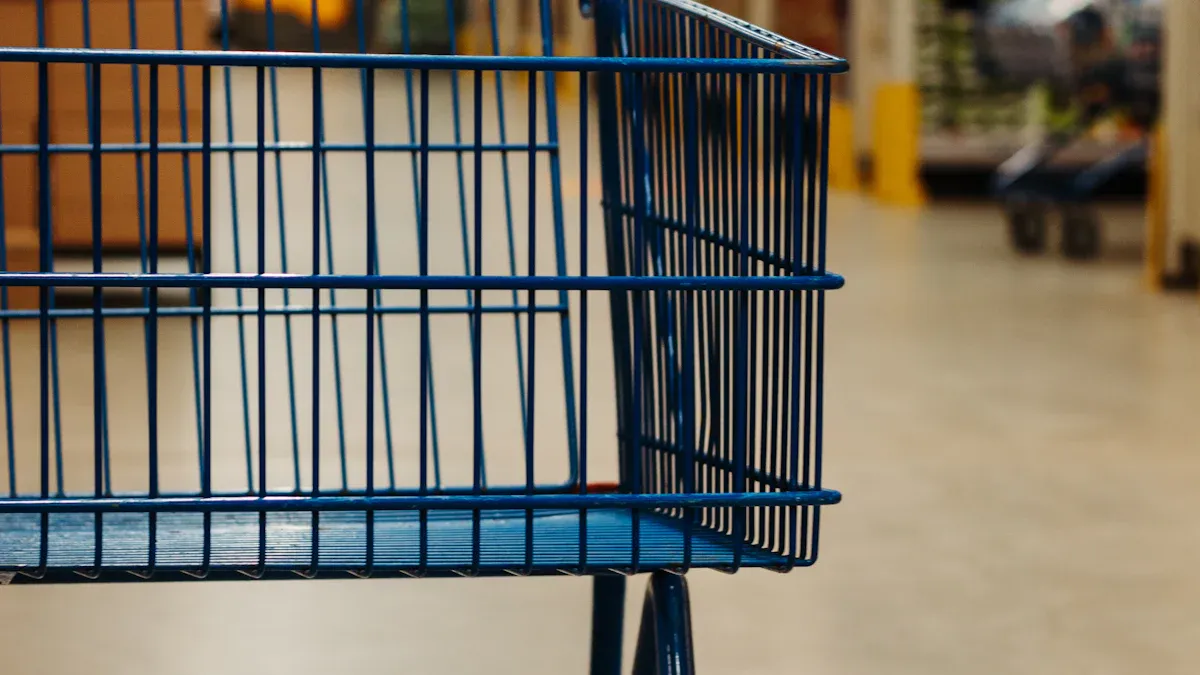
Examples of Traditional Checkout Systems in Use
Traditional checkout systems are still common in many stores. You can see them in grocery stores, department stores, and small shops. These systems use barcode scanning and payment machines. During busy times, they can be slow, but they work well for people who like talking to staff or need help with returns.
Self-checkout kiosks are a helpful upgrade to these systems. They let you scan and pay for items by yourself, which saves time. Many grocery stores use these kiosks to serve more customers quickly. Even though 80% of people still need help using them, new technology is making them easier and better to use.
Traditional systems also help keep shopping safe. Workers can watch transactions to stop theft. These systems often include tools like SSL encryption to protect payment information, making shopping secure.
Vision-Powered Systems in Action: Cloudpick's Unmanned Store
Cloudpick's Unmanned Store shows how vision-powered systems work. The store uses smart cameras to track what you pick up. Payments happen automatically when you leave, so there are no lines. This makes checkout faster and helps the store run more smoothly.
The store doesn’t need cashiers, which lowers labor costs. The system learns your shopping habits and gives you suggestions. It also keeps shelves stocked, saving time and making shopping easier. Faster service and shorter lines make customers happier. The cameras also improve security by watching store activities.
Future Trends in Cart Checkout Solutions
The future of checkout systems looks exciting with new technology. Self-checkout machines are becoming more popular, and AI tools are helping stores manage stock and assist customers. For example, Nike’s self-checkout kiosks cut checkout times by 76%, and Walmart’s Scan & Go reduced wait times by 40%.
Smart carts with cameras are also becoming popular. These carts recognize items as you put them in, so you don’t need to scan them. AI tools for managing inventory are another big trend. They can cut out-of-stock items by 50% and lower storage costs by 30%. By 2024, AI is expected to handle 85% of customer questions, making shopping even easier.
Retailer | Technology Used | Impact on Checkout Time/Capacity |
|---|---|---|
Nike | Self-checkout kiosks | Cut checkout times by 76%, increased capacity by 19% |
Walmart | Scan & Go technology | Reduced checkout time by 40% |
Target | Multiple payment options | Helped grow digital sales by 195% in 2020 |
These changes show how AI and vision-powered systems are improving shopping. They make it faster, smarter, and more efficient for everyone.
Traditional checkout systems depend on people, which causes slow service and higher costs. Vision-powered systems use AI and smart cameras to speed up tasks. These systems make checkout 75% faster, save money, and keep customers happy.
Stores using vision-powered tools see big improvements. AI helps reduce empty shelves by 30%, boosts customer loyalty by 42%, and cuts extra stock by 25%. The chart below shows these benefits clearly:
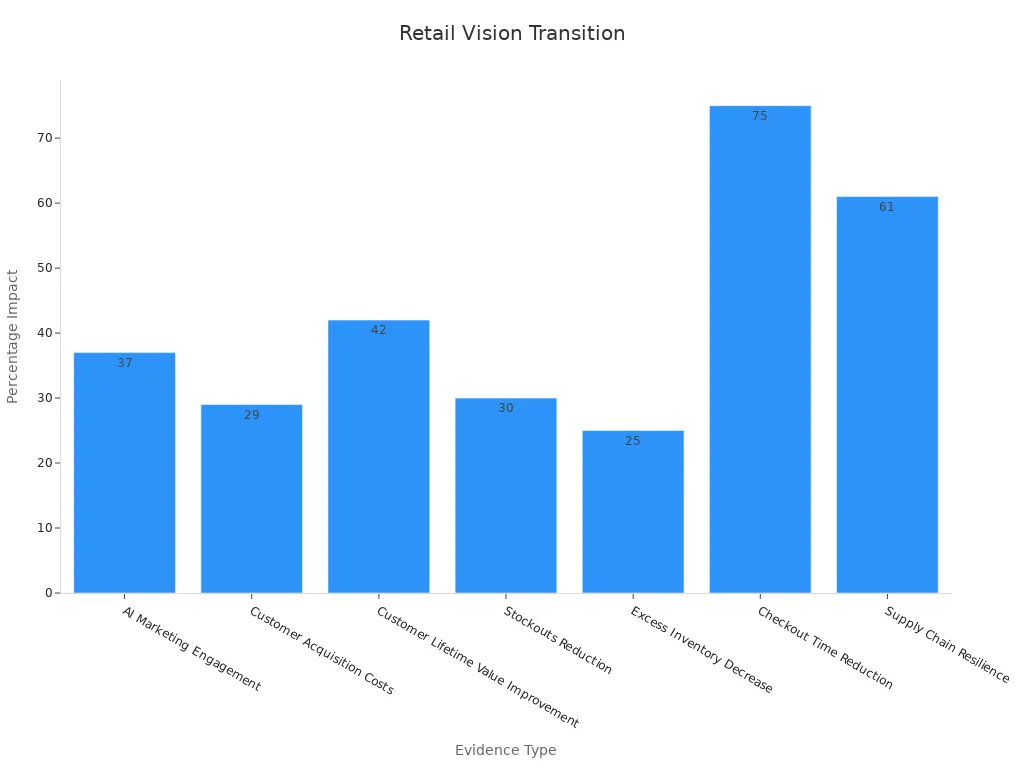
To switch successfully, choose systems like Cloudpick’s Unmanned Store. Look for tools with AI to manage stock, understand shoppers, and allow easy payments. Using computer vision can turn your store into a fast and modern place that fits today’s shopping needs.
FAQ
What’s the big difference between traditional and vision-powered systems?
Traditional systems need people to scan items and help. Vision-powered systems use AI and cameras to do this automatically. They work faster and save time.
Are vision-powered systems costly to set up?
Yes, they cost more at first. But they save money later by needing fewer workers and running more smoothly. Over time, the savings are worth it.
How do vision-powered systems make shopping better?
These systems remove long waits and scanning steps. Cameras track items quickly, making checkout faster. They also give stores helpful shopping tips for customers.
Can small stores use vision-powered systems?
Yes, systems like Cloudpick’s Unmanned Store can fit any store size. They work well in small shops and big stores, making them useful for all businesses.
Are vision-powered systems safe?
Yes, they use smart AI and encryption to keep payments secure. Features like fraud checks and live monitoring protect shoppers and stores.
See Also
The Impact of AI Tools on E-Commerce Store Management
Boosting Efficiency and Customer Experience with Cloudpick Checkout
Walgreens Self-Checkout: Balancing Convenience and Retail Challenges
Modern Retail Benefits from AI-Driven Combo Vending Machines
Introducing Cashierless Shopping Solutions with Cloudpick Technology
